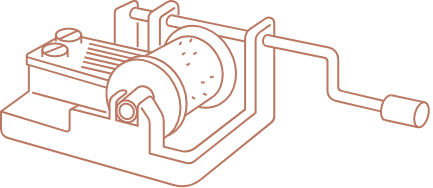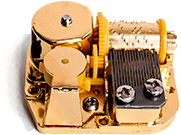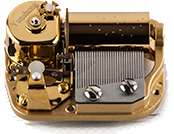how it worksWIND-UP MUSIC BOX MECHANISM

How it works?
The wind-up musical box mechanism works with a cylinder that moves as long as the mechanism is wound, in the same way that a mechanical watch works. Unlike the crank mechanism that only sounds while turning a crank at the end of the mechanism, the wind-up mechanism has a key at the bottom that is turned clockwise by hand to load the wind-up, so that once it is released, it starts to sound automatically. The wind-up device transmits the force through various gears to a cylinder, which has a series of spikes that make the tines sound, generating the song.
When this wind-up mechanism is installed in a box, it will sound as long as the box is open and has enough wind-up to move the cylinder. When the box is closed, the lid will move a small device that is included in the mechanism and will block the rotation of the cylinder, automatically stopping the song.
As with the crank musical mechanism, to achieve a good volume result, it is necessary that the mechanism is installed on a rigid base; in this way, the vibrations of the tines will be transmitted to the surface of the other material and the volume will be amplified. The sound of this mechanism directly in the air is practically inaudible.
The speed of the song in this case will depend directly on how much the wind-up has been loaded: the mechanism will sound faster the more wind-up it has, and will slow down as the wind-up is used up. In general, any melody we have available will sound at the correct speed regardless of the small speed variation of the mechanism.
While in the crank musical mechanism it is possible to manually control the speed, in the wind-up mechanism it cannot be modified, as it sounds in a completely autonomous way.
The wind-up mechanism is more complex than the crank and has more parts involved in its operation: a key that is turned by hand transmits the movement to a shaft containing a spring, which is compressed as the key is turned; when you stop turning it, the spring makes force and moves the shaft in the opposite direction, transferring this energy to a cylinder through toothed wheels. This cylinder is the one that vibrates the tines of the comb, producing the sound. It also has a series of devices that make resistance to the rotation of the cylinder so that it rotates at the correct speed.

18 notes wind-up mechanism
This mechanism can play songs of approximately 16-20 seconds. Its comb consists of 18 notes, so the vast majority of songs can be performed on this mechanism. The drum and comb is identical to the crank mechanism; the only difference is that the wind-up mechanism is semi-automatic.
You can see all the tunes that can be performed on this type of mechanism following this link.

30 notes wind-up mechanism
This mechanism can play songs of approximately 30-35 seconds. Its comb consists of 30 notes, so almost all songs can be performed on this mechanism. The drum and comb is much larger than the 18-note one, as is its overall quality, both in sound and workmanship.
You can see all the tunes that can be performed on this type of mechanism following this link.
